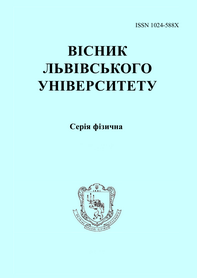DOI: https://doi.org/10.30970/vph.55.2018.40
²R-spectral analysis organicplastics based on polychlorotrifluoroethylene
O. I. Burya, S. V. Kalinichenko, S. P. Suchilina-Socolenko, A.-M. V. Tomina, A. I. Synelna

| Visnyk of the Lviv University. Series Physics
55 (2018) ñ. 40-49
DOI: https://doi.org/10.30970/vph.55.2018.40 ²R-spectral analysis organicplastics based on polychlorotrifluoroethyleneO. I. Burya, S. V. Kalinichenko, S. P. Suchilina-Socolenko, A.-M. V. Tomina, A. I. Synelna |  |
Physico-chemical and mechanical properties of polymer composite materials depend on intermolecular interaction between matrix and filler. In this regard, ²R-spectra of polymer composite materials based on polychlorotrifluoroethylene reinforced with Talon T700 polysulfonamide organic fiber are given in the article. It is determined that there is an interaction between polymericfluorine matrix and organic fibers. Compering ²R-spectra of initial polymer and composites on its base, it can be indicated that the greatest deviations of the spectra are observed in such areas as: \numax=3414,6 cm-1 is polymer area of carbon bonds, \pi -\bar{e} is the conjugation of olefin; doublet 2921,3 and 2851,6 cm-1 that corresponds to enol composites of carboxylic acids, Í is the bond due to ÎÍ-groups; \nu(CF2)=1384,5 cm-1; \nu(C-F)=1125 cm-1; \nu(=CFCl)=490,8 cm-1; \nu(perfluoroketones)=587,3 cm-1; \nu(=C-F)=1125,8 cm-1. This may indicate that not only active groups of Tanlon T700 have an impact on the matrix, but also the matrix itself interacts with the fiber due to ultimate double bonds, the emergence of new H-bonds of redistribution of \pi -\bar{e} between two components, and also due to the emergence of covalent bonds between the groups modified in the design processes (enol, perfloroketone oxo- and carboxyl). The strongest inter-component interaction manifests itself for organoplastic containing 20 mass.\% of the filler.